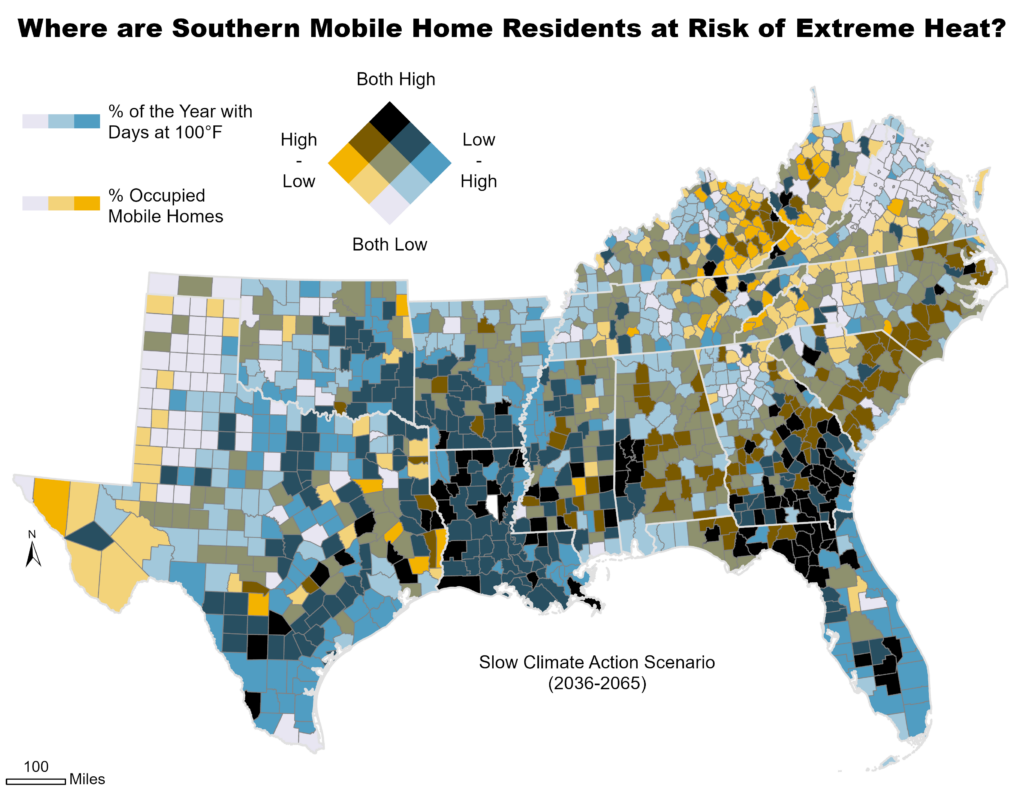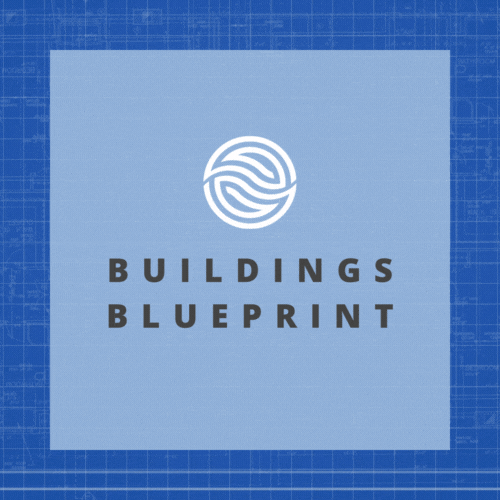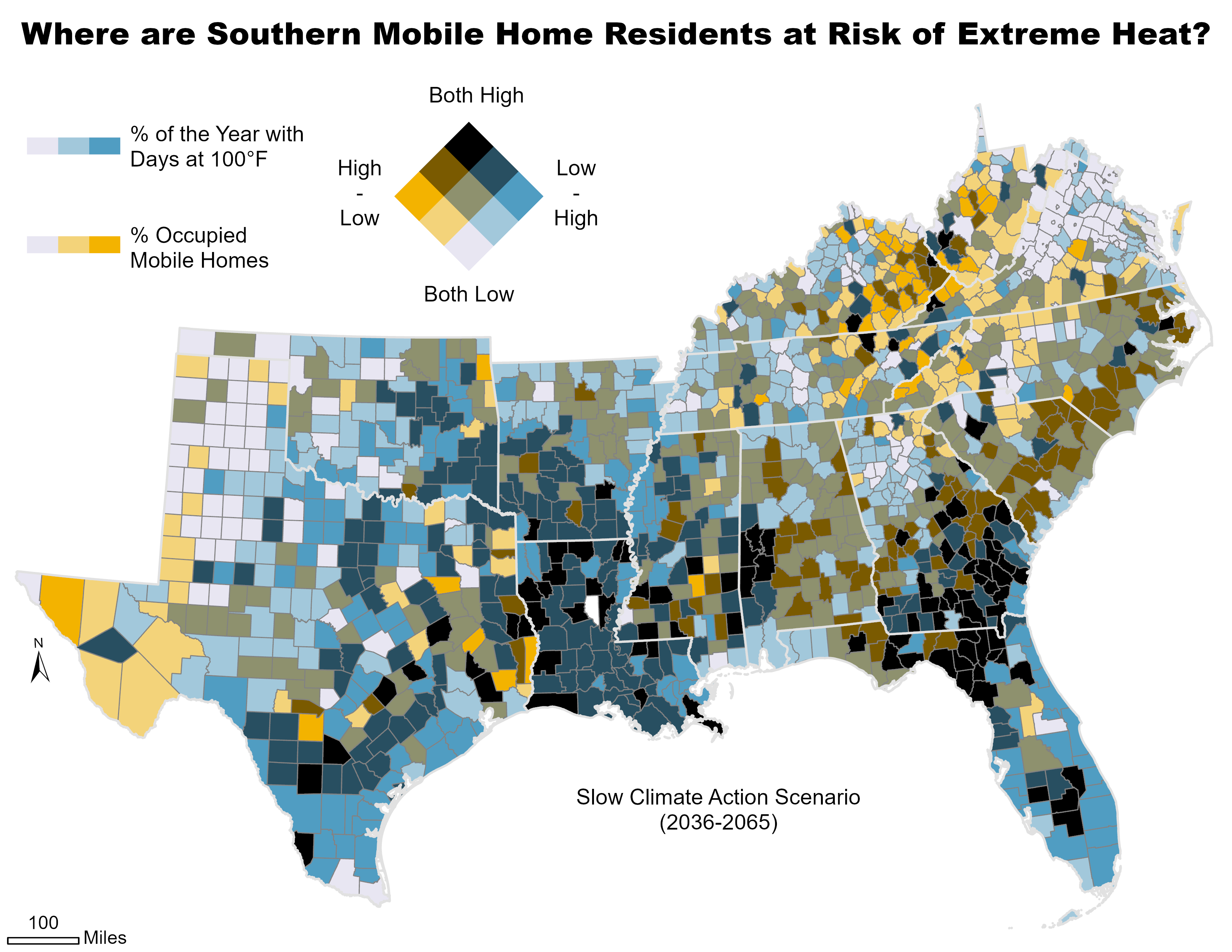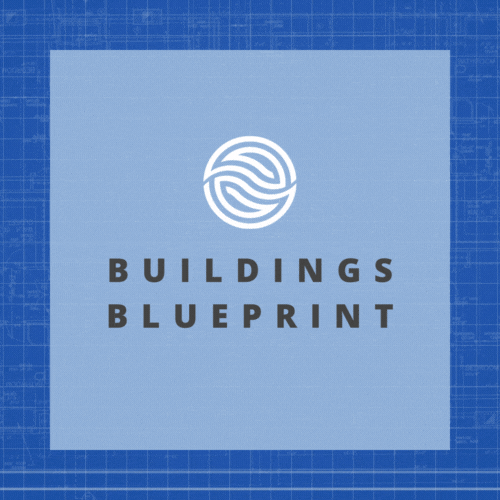Month: April 2024
April Map of the Month
By: Laura Diaz-Villaquiran

Source: Union of Concerned Scientists, “Killer Heat in the United States” U.S. Census Bureau, Physical Housing Characteristics for Occupied Housing Units
Extreme heat is the leading cause of weather-related death in the United States, and Southeast communities are particularly vulnerable to heat impacts as the climate warms. This vulnerability is not distributed evenly across the region, however. Research suggests that residents of mobile homes are among the most vulnerable to the impacts of extreme heat, with one 2021 study finding that mobile home residents are six to eight times more likely to die from heat-related illness than people who live in other types of housing.
The South has the nation’s largest share of mobile homes, and this month’s map considers where mobile home residents may be at the highest risk from expected increases in the prevalence of extreme heat by the middle of the century (2036-2065). Counties on the map shaded in dark blue have a high proportion of mobile homes—at least a quarter of the occupied housing units in those counties—and a high percentage of days with heat index values above 100°F. As the map indicates, these factors are overrepresented in counties in Florida, Texas, Louisiana, Georgia, Alabama, and Mississippi.
Research shows that people may experience elevated health risks —including respiratory and cardiovascular issues that can result in death—when exposed to temperatures of 80°F or more. Risks depend on a range of factors, including the length of exposure, physical activity, overall health, local environmental conditions, and how acclimated people are to those conditions. Outdoor workers, children, elderly people, those who are pregnant, and people with underlying health conditions are most susceptible. These risks can be magnified by housing quality and access to affordable energy. A report from the Union of Concerned Scientists notes, “When nights remain hot, health risks rise, especially for those without access to air-conditioning or for whom the choice of turning on the air-conditioning presents difficult financial trade-offs.”
These issues are often magnified in mobile homes, which, on average, have energy costs that are double those costs in stick-built homes. Recent estimates from the U.S. Census Bureau’s Household Pulse Survey indicate that 37% of people living in mobile homes, and earning less than $25,000 a year, kept their homes at an unsafe temperature to offset their cost-of-living expenses. Additionally, mobile home residents are more likely to face other “concentrated disadvantages” that include high energy burdens, lower-than-average incomes, a greater likelihood of living in rural areas that lack robust health and social services, and more.
Understanding future scenarios like this enables us to anticipate challenges for individuals residing in mobile homes while helping identify opportunities to leverage energy efficiency to mitigate heat-related illnesses and improve resiliency. These approaches could include home weatherization, implementing high-energy efficiency upgrades, and renewable energy retrofits. Additionally, targeted state and federal funding could prioritize communities that are most at risk of experiencing extreme heat in the coming decades.
National Emissions Standards: Unleashing Health & Economic Potential for the Southeast
By: Justin Brightharp
On March 20th and March 28th, the United States Environmental Protection Agency (U.S. EPA) finalized national emissions standards for passenger cars, medium-duty trucks and vans, and heavy-duty vehicles, respectively, applying to vehicle model years 2027 through 2032. These standards are expected to establish the United States as a leader in the clean transportation space, improve air quality, and lower fuel and operating costs for consumers.
Light-duty and Medium-duty Standard Projected Benefits
- CO2 reduced by 7.2 billion metric tons
- $13 billion in annual health benefits
- Particulate Matter reduced 8,700 tons by 2055
- NOx reduced 36,000 tons by 2055
- Volatile Organic Compounds reduced by 150,000 tons by 2055
- $46 billion in reduced annual fuel costs by 2055
- Almost $16 billion in reduced annual maintenance and repair costs
Heavy-duty Standard Projected Benefits
- 1 billion metric tons of greenhouse gas emissions avoided from 2027 to 2055
- Reduce air pollution for 72 million people near freight routes
- $13 billion in annualized benefits through 2055:
- $10 billion in climate benefits
- $300 million in benefits from PM reduction
- $3.5 billion in annual savings
Both standards are performance-based emissions, allowing flexibility in building gasoline vehicles with better engines and transmissions and increasing access to energy-efficient vehicle options like hybrid electric vehicles, plug-in hybrid electric vehicles, battery-electric vehicles, and hydrogen fuel cell vehicles. The southeast is home to billions of dollars in private investments from manufacturers along the electric vehicle supply chain, expecting tens of thousands of jobs. The transition towards transportation electrification will benefit the entire United States and local communities across the Southeast.
Projected Electric Vehicle Manufacturing Investments by State 2023

Map: SEEA. Data Source: Atlas Public Policy EV Hub Automaker Dashboard
Projected Electric Vehicle-Specific Jobs by State in the Southeast

Map: SEEA. Data Source: Atlas Public Policy EV Hub Automaker Dashboard
Supporting electric vehicle production requires manufacturing batteries, building vehicle chassis and bodies, building and deploying charging stations, vehicle and charging station maintenance, and battery recycling, all of which can be found in the southeast region. The U.S. EPA projects that 67% of new light-duty vehicle sales and 46% of new medium-duty vehicles could be electric due to the new emissions standards. Thousands, if not millions, of electric vehicles sold in the United States and globally could be built in the southeast region with rippling effects.
For every 100 direct jobs in a durable manufacturing industry, like automotive, over 744 indirect jobs are created. Through 2025, the Southeast region’s existing and announced private investments are expected to bring $93 billion and almost 170,000 direct manufacturing jobs for electric vehicles. This could mean over 1.2 million additional jobs from suppliers and induced jobs from existing and future businesses, including small businesses.
Projected Indirect Jobs from Electric Vehicle Manufacturing in the Southeast 2023

Map: SEEA. Data Source: Economic Policy Institute Employment Multiplier Report. Jan. 2019
The national emission standards for light-duty and medium-duty vehicles, as well as heavy-duty vehicles, provide consumers with health benefits and cost savings and emphasize consumer choice. One of the pathways to improved air quality and health, as well as affordable electric vehicles, for the United States, runs through many communities in the Southeast. The Southeast is poised to see economic growth and the many health and cost benefits from both emissions standards through the thousands of manufacturing jobs created by the electric vehicle supply chain and over a million indirect jobs. Coupled with federal tax incentives: $7,500 for new light-duty electric vehicles, $4,000 for used electric vehicles, and $40,000 for new commercial medium- and heavy-duty electric vehicles built in the United States and the billions of dollars of public investment from the Bipartisan Infrastructure Law and Inflation Reduction Act, we can further accelerate towards cleaner air and better health in our communities.
Buildings Blueprint (1st Quarter)
By Olivia Begalla & Maggie Kelley Riggins

Hello! Welcome to SEEA’s inaugural issue of Buildings Blueprint, the latest quarterly newsletter dedicated to the building industry community. This publication is your guide to the ever-evolving landscape of buildings and energy codes in the Southeast and the U.S. islands, offering updates and resources to empower built environment professionals to excel in their roles.
Energy Code Updates
Legislation has been filed in South Carolina to update the commercial building energy code from the 2009 IECC to the 2021 IECC, standing to save over $900k in energy costs in the first year. SEEA is actively completing a residential energy code field study in the state to inform stakeholders and decision-makers with on-the-ground data for a residential energy code update in the future.
On January 18th, 2024, Virginia officially adopted the 2021 editions of the Uniform Statewide Building Code, the Statewide Fire Prevention Code, the Industrialized Building Safety Regulations, and the Amusement Device Regulations. The updates include an array of energy efficiency enhancements, including Virigina-specific HVAC sizing, fenestration and wall insulation, and ventilation. The state board was directed in January to reduce regulations by 25%; however, industry stakeholders made public comments to the Virginia Housing and Community Development Board to ensure the stakeholder-developed codes stayed intact after a two-year process. To view the 2021 regulations, click here.
Florida officially adopted the eighth edition of the Commercial and Residential Florida Building Code, which became effective on December 31st, 2023. The updated edition includes changes to commercial envelope insulation and testing, commercial minimum efficiency HVAC requirements, residential performance-based compliance, and more. To view a list of Florida building code resources, click here.
For more energy code information, check out energycodes.gov.
Training & Education
Building a more energy-efficient workforce? The Louisiana Housing Corporation’s (LHC) state-of-the-art Weatherization Training Center in Baton Rouge offers a variety of weatherization courses and is a BPI Testing Center and IREC Accredited Provider. Experiential courses include classroom and hands-on training in all aspects of residential weatherization, including combustion safety testing with live gas appliances, insulation and airsealing, and energy auditor protocols. The center can train up to 30 people at a time, offer classroom and specialized field training, and provide training for administrative personnel. Take a virtual tour of the center today!
The U.S. Department of Energy Building Energy Codes Program (BECP) has launched a free resource hub to support training and education for various building energy code-related topics. This central platform is designed to assist stakeholders in adopting, implementing, and complying with building energy codes. The hub contains various training resources, including webinars, presentations, and software, all created to advance energy code education.
Check out the Clean Energy Clearinghouse, which has free educational resources and CEU-bearing courses for all clean energy stakeholders – including authorities having jurisdiction (AHJs), fire departments, clean energy contractors, manufacturers and suppliers, electric utilities, building owners, facility managers, and others— to benefit from current and timely information related to renewable energy developments.
Regional Investment
In July 2023, SEEA was awarded three Resilient Energy Codes Implementation grants from the Department of Energy, totaling $4.7 million to support healthier, more efficient housing in the region. As of January 2024, all three of these energy code projects are underway.
Securing Code Advancements in Louisiana
In collaboration with the Louisiana Office of the State Fire Marshall, Louisiana Department of Natural Resources, American Institute of Architects Louisiana, Green Coast Enterprises, University of Louisiana-Lafayette, and the International Code Council, SEEA is providing training and technical assistance on the most recent residential and commercial energy code updates to the building energy workforce in Louisiana. Implementing an updated energy code supports a stronger, more diverse workforce and lays the foundation for future funding applications. Residents in Louisiana are estimated to save 1.026 MMT of CO2 over five years, equivalent to removing 45,663 gasoline-powered cars from the road over the same period, by adopting and implementing the new energy code.
Georgia Residential Field Studies: Single and Multifamily
SEEA is working with state leaders, including the Georgia Environmental Finance Authority, Built Environment LLC, Greater Atlanta Homebuilders Association, Georgia Power Company, Oglethorpe Power Company, Conditioned Air Association of Georgia, and ECO-Action to conduct single-family and multifamily energy code compliance studies. This is the first multifamily energy code compliance study in the Southeast. These studies will prepare the Georgia homebuilding industry for an advanced energy code adoption process and identify energy code training and education gaps. Meeting updated energy code standards for new construction and major renovations will help Georgia residents save an estimated $ 210 million in energy costs over five years.
Closing Equity Gaps to Advance Codes and Standards
With our partners, the National Renewable Energy Laboratory, the City of Atlanta, the City of Savannah, and the Georgia Environmental Finance Authority, SEEA seeks to understand and repair the impacts of historical disinvestment in the equitable implementation of building performance standards. The group is developing novel data tools to account for the financial and social costs of inequitable standards, calculate the investment needed to build equitably improve building performance, and develop and deploy a replicable policy and program community toolkit. The team is piloting this approach in Atlanta and Savannah, partnering with civic and community leaders, including those from disinvested areas, small business owners and staff, residential renters, and homeowners. The project team estimates $1.6 billion in energy cost savings over five years.
Buildings UP Southeast Regional Navigator
In August of last year, SEEA began supporting the U.S. Department of Energy in the implementation of its first-ever Buildings Upgrade Prize (Buildings UP). The goal of Buildings UP is to quickly and equitably upgrade existing residential and commercial buildings across the country to provide cleaner, more efficient, and affordable energy to occupants while providing project teams with a robust network of technical assistance support to ensure success. SEEA serves as a regional navigator and technical assistance provider, guiding 10 out of the 45 nationally awarded teams, whose pilot initiative(s) will be implemented in existing buildings in the Southeast region and U.S. Island territories. All 10 SEEA teams are in the equity-centered innovation prize pathway, which goes even more in-depth to engage the community and consider potential impacts, also covering 75% of upgrade costs.
- Appalachian Voices– (Project state: VA) – Appalachian Voices will build off their solar initiatives to deploy electrification technologies in community anchor buildings across Virginia’s coal communities and build a network of resilience hubs throughout the flood-impacted region.
- Community Housing Partners– (Project state: VA) Community Housing Partners are prioritizing decarbonization strategies in rural, mission-driven, multifamily communities in Virginia that don’t generate the revenue needed for capital reinvestment.
- Green The Church– (Project states: CA, FL) – Green the Church plans to implement building energy upgrades for Black Churches, initially piloting in West Oakland, California’s economically disadvantaged and historically segregated communities, followed by 15 additional upgrades in EJ communities across FL, GA, LA, and TX.
- Groundswell– (Project states: GA, AL) Groundswell will develop the plan and partnerships needed to expand and scale their Save on Utilities Long-term program (SOUL), which delivers energy efficiency upgrades and improves housing equity in disadvantaged, rural areas.
- Hijra House- (Project state: MS) The Hijra House Just Energy Initiative (JEI) engages underserved areas across nine Southern Mississippi counties, offering an innovative model for accelerating building upgrades, economic development, and local health goals.
- Louisville/Jefferson County Metro Government (LMG) – (Project state: KY) The Louisville team will be building on their successful Communities Local Energy Action Plan (C-LEAP) to achieve just clean energy transition in their affordable housing sector.
- New North Carolina Project- (Project state: NC) The New North Carolina project will develop a cohort model that builds a collaborative approach to support residential communities to receive building upgrades.
- Shifted Energy– (Project state: HI) Shifted Energy works in Hawaii’s tribal lands to support equitable energy and resiliency solutions for underserved indigenous communities.
- Together New Orleans– (Project state: LA) Together New Orleans will develop 74 resilience hubs in underserved nonprofit houses of worship in New Orleans, Louisiana, by weatherizing buildings, increasing energy savings, and utilizing solar power.
- West Anniston Foundation– (Project state: AL) The West Anniston project will provide building upgrades through building assessments and installation of heat pumps, health and safety, and energy efficient measures in environmental justice communities in West Anniston, Alabama.
Bloomberg American Sustainable Cities
Bloomberg Philanthropies announced its list of 25 U.S. cities receiving direct investment to leverage and implement federal funds to advance local projects. Of the 25 selected cities, 12 are in SEEA’s region and have the opportunity to develop affordable energy-efficient housing and increase equitable access to clean energy, among other initiatives.
- Birmingham, AL
- Montgomery, AL
- Atlanta, GA
- Savannah, GA
- Jackson, MS
- Charlotte, NC
- Raleigh, NC
- Chattanooga, TN
- Memphis, TN
- Nashville, TN
- Hampton, VA
- Newport News, VA
Funding
Concept papers for the Resilient Energy Codes Implementation Funding Opportunity Announcement (FOA) —Round 2— are due April 5th, 2024, at 5:00 PM ET. This initiative is a key component of the Biden-Harris Administration’s Investing in America campaign. It allocates $90 million to states, local governments, and tribes to support adopting and implementing modern building codes and develop related technical assistance. Applications can be submitted here.
Full applications for the competitive IRA Buildings Code FOA issued by The Office of State and Community Energy Programs (SCEP) are due April 30th, 2024. Funded by Biden’s Inflation Reduction Act (IRA), the initiative aims to provide up to $1 billion to states and local governments to adopt the latest model energy codes, zero energy codes, or building performance standards. Applications can be submitted here.
Applications for DOE’s 2024 Renew America’s Schools Prize are open. The second round of this funding will award up to $180 million to school districts across the country to implement upgrades, build partnerships, and build capacity. Applications are due Thursday, June 13th, 2024, at 5:00 PM ET. More information can be found here.
Events
National Energy Codes Conference – May 6-8, 2024 – Sacramento, California
Join SEEA staff at the National Energy Codes Conference this May in California! This national conference will have training, engaging sessions, and networking opportunities and is designed for energy code users and participants of all types. Building officials, builders, state energy offices, trade associations, energy efficiency organizations, architects, engineers, policymakers, manufacturers, utilities, code administrators, educators, researchers, and more are all encouraged to attend!
Registration & Hotel Information
Getting to Zero Forum – May 21-23, 2024 – Charlotte, North Carolina
Early registration is now open for the Getting to Zero Forum in Charlotte, NC, this May! This forum brings together industry leaders and experts to discuss the best approaches to reducing energy demand and advancing decarbonization through policies, programs, and projects. With an anticipated attendance of over 600 leading policy makers, designers, building owners, systems manufacturers, and commercial real estate professionals, participants will explore transformative opportunities for achieving zero energy and carbon in the built environment.
Registration & Hotel Information
ACEEE Buildings Summer Study – August 4-9, 2024 – Pacific Grove, California
The 2024 Summer Study on Energy Efficiency in Buildings, hosted by the American Council for an Energy-Efficient Economy, will take place this August in California! Summer Study brings together professionals from around the globe to the Asilomar Conference Grounds to collaborate, debate, and advance the technologies, practices, and research necessary to equitably decarbonize the building sector in a manner that addresses the urgency of the climate crisis. This year, the theme is Equity and Climate Action: Time to Deliver, highlighting the immediate need for action that creates equitable climate solutions.
Registration & Hotel Information
Southeast Energy Summit – November 20-22, 2024 – Nashville, TN
Save the date! The annual Southeast Energy Summit brings together the brightest minds in the industry to connect, explore and innovate for a more energy-efficient Southeast. Join us November 20-22, 2024 in Nashville, TN to dive into dynamic discussions, celebrate regional accomplishments, and enjoy fun networking events! More details coming soon!
Publications
Increasing Equitable Access to Heat Pump Water Heaters (Maggie Kelley Riggins, senior program manager) – This whitepaper, published in March 2024 by the Advanced Water Heating Initiative (AWHI) examines programs across the nation that are working to expand equitable access to heat pump water heaters.
Federal Funding Investment in the Southeast and the U.S. Territories (Grace Parker, research associate) – This collection of white papers and accompanying dashboards provide insight into the purpose, location, and type of funding invested in the Southeast from the $550 billion Bipartisan Infrastructure Law. Read more here.
Thank you for reading! We hope that you enjoyed the Buildings Blueprint and that this information helps you in your work to increase equitable access to energy in buildings in our region (and beyond!).
Sincerely,
Maggie Kelley Riggins, SEEA
Senior Program Manager
Have questions or want to collaborate with SEEA staff? Want something shared in our next Buildings Blueprint?
Subscribe to the building’s newsletter here.



